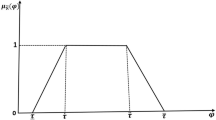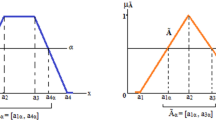Abstract
Comparing analytical approaches is crucial when important policy decisions of corporations or government agencies may be influenced by results that depend on the methodologies certain disciplines customarily use. Technical efficiency can be measured by a full-frontier production function model or by linear programming specifications. By using these modeling approaches observations pertaining to three linerboard manufacturing facilities are classified as efficient, inefficient, scale inefficient, and other. However, observations may or may not be consistently classified into these four groups when employing the two modeling approaches. In order to validate the efficiency designations of the two modeling approaches and to determine the uniqueness of observations, a fuzzy K-means clustering approach that uses a modified hat matrix H * as a similarity or information matrix is employed. This approach permits observations to be allocated to clusters in a fuzzy way by defining a membership function from 0 to 1. As the degree of fuzziness increases, a sensitivity analysis with respect to individual observations belonging to some cluster can be evaluated. At the same time, this fuzzy approach assists the analyst to assess the inconsistencies that can arise when using the mathematical programming and full-frontier modeling approaches of technical efficiency.
Similar content being viewed by others
References
Afriat, S.N. (1972). “Efficiency Estimation of Production Functions.” International Economic Review 13, 569–598.
Andrews, D.F. and D. Pregibon. (1978). “Finding the Outliers that Matter.” Journal of the Royal Statistical Society, Series B 40, 85–93.
Bellman, R.E. and L.A. Zadeh. (1970). “Decision Making in a Fuzzy Environment.” Management Science 17, 141–164.
Bezdek, J.C. (1981). Pattern Recognition with Fuzzy Objective Function Algorithms. New York: Plenum Press.
Britt, K. (1970). Handbook of Pulp and Paper Technology. New York: Van Nostrand Reinhold.
Charnes, A., W.W. Cooper, and T. Sueyoshi. (1988). “A Goal Programming/Constrained Regression Review of the Bell System Breakup.” Management Science 34, 1–26.
Cormack, R.M. (1971). “A Review of Classification.” Journal of the Royal Statistical Society, Series A, 134, 321–367.
Dempster, A.P. and M. Gasko-Green. (1981). “New Tools for Residual Analysis.”Annals of Statistics 9, 945–959.
Dillow, W.R. and M. Goldstein. (1984). Multivariate Analysis: Methods and Applications. New York: Wiley.
Dogramaci, A. (1981). “Perspectives on Productivity. ” In A. Dogramaci (ed.), Productivity Analysis: A Range of Perspectives. New York: Kluwer-Nijhoff Publishing.
Dunn, J.C. (1974). “Some Recent Investigations of a New Fuzzy Partitioning Algorithm and Its Application to Pattern Classification Problems.” Journal of Cybernetics 4, 1–15.
Färe, R., S. Grosskopf, and C.A.K. Lovell. (1984). Measurement of Efficiency of Production. Boston: Kluwer-Nijhoff Publishing.
Färe, R. and C.A.K. Lovell. (1978). “Measuring Technical Efficiency of Production.” Journal of Economic Theory 19, 150–162.
Farrell, M.J. (1957). “The Measurement of Productive Efficiency.” Journal of the Royal Statistical Society, Series A 120, part 3, 253–281.
Gray, J.B. and R.F. Ling. (1984). “K-Clustering as a Detection Tool for Influential Subsets in Regression.” Technometrics 26, 305–318.
Greene, W.H. (1980). “Maximum Likelihood Estimation of Parametric Frontier Production Function.” Journal of Econometrics 13, 5–25.
Hadi, A.S. (1985). “Letters to the Editor: K-Clustering and the Detection of Influential Subsets.” Technometrics 27, 323–325.
Hadi, A.S. (1990). “Two Graphical Displays for the Detection of Potentially Influential Subsets in Regression.” Journal of Applied Statistics 17, 313–327.
Hartigan, J.A. (1975). Clustering Algorithms. New York: Wiley.
Hoaglin, D.C. and R.E. Welsch. (1978). “The Hat Matrix in Regression Analysis.” The American Statistician 32, 17–22.
Kandel, A. (1982). Fuzzy Techniques in Pattern Recognition. New York: Wiley.
Kaufman, L. and P.J. Rousseeuw. (1990). Finding Groups in Data: An Introduction to Cluster Analysis. New York: Wiley.
Kopp, R. (1981). “The Measurement of Productive Efficiency: A Reconsideration.” Quarterly Journal of Economics, 96, 476–503.
Milligan, G.W. (1980). “An Examination of the Effect of Six Types of Error Perturbation of Fifteen Clustering Algorithms.” Psychometrika 45, 325–342.
Ohashi, Y. (1984). “Fuzzy Clustering and Robust Estimation,” presented at the 9th SAS Users Group International Meeting in March 1984 in Hollywood Beach, FL.
Punj, G. and D.W. Stewart. (1983). “Cluster Analysis in Marketing Research: Review and Suggestions for Application.” Journal of Marketing Research 20, 134–148.
Rousseeuw, P.J. and B.C. van Zomeren. (1990). “Unmasking Multivriate Outliers and Leverage Points.” Journal of the American Statistical Association 85, 633–651.
SAS Institute Incorporated. (1985). SAS Users Guide: Statistics Version 5 Edition, Cary, NC: SAS Institute Incorporated.
Seaver, B.L., and K.P. Triantis. (1989). “The Implications of Using Messy Data to Estimate Production-Frontier-Based Technical Efficiency Measures.” The Journal of Business and Economic Statistics 7, 49–59.
Seaver, B.L., and K.P. Triantis. (1993). “The Impact of Outliers and Leverage Points on Technical Efficiency Measurement Using Robust Procedures,” Management Science, to appear.
Seaver, W.L. and J.E. Lee. (1987). “A Statistical Examination of Sky Cover Changes in the Contiguous United States.” Journal of Climate and Applied Meteorology 26, 88–95.
Sink, D.S. (1985). Productivity Management: Planning, Measurement and Evaluation, Control and Improvement. New York: Wiley.
Triantis, K. (1984). “The Measurement of Efficiency of Production: The Case of Linerboard Manufacturing.” Unpublished Ph.D. dissertation, Columbia University.
Wong, M.A. and T. Lane. (1983). “A Kth Nearest-Neighbor Clustering Procedure.” Journal of the Royal Statistical Society, Series B, No. 3, 362–368.
Wong, M.A. and C. Schaak. (1982). “Using the Kth Nearest-Neighbor Clustering Procedure to Determine the Number of Subpopulations.” ASA 1982 Proceedings of the Statistical Computing Section, 40–48.
Author information
Authors and Affiliations
Additional information
The refereeing process of this paper was handled through Rolf Färe. The majority of this research work was completed when Bill Seaver was at the Department of Management Information Resources, College of Business Administration, Western Illinois University, Macomb, IL 61455.
Rights and permissions
About this article
Cite this article
Seaver, B.L., Triantis, K.P. A fuzzy clustering approach used in evaluating technical efficiency measures in manufacturing. J Prod Anal 3, 337–363 (1992). https://doi.org/10.1007/BF00163432
Issue Date:
DOI: https://doi.org/10.1007/BF00163432




